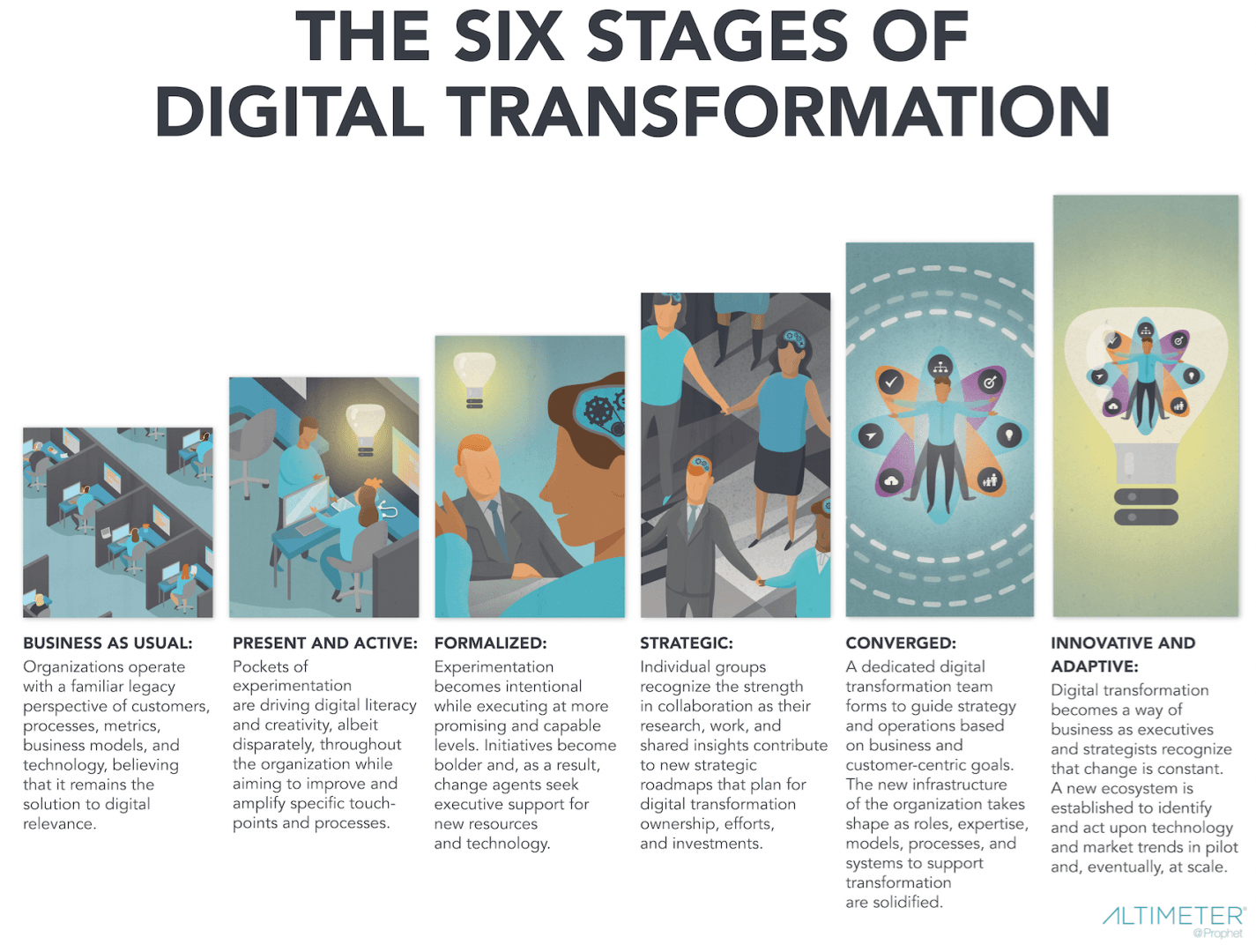Digital transformation has become the fuel for businesses all around the world to adapt to today's always-changing time. That is so as digital tools allow companies to discover new ways to engage with their customers while open up strategies and models hardly seen before. Within this context, leading brands are the ones taking advantage in the digital transformation race. Along the way, they even have the power to disrupt whole industries, well established in the market for years. Amazon would be just a perfect example of this. Jeff Bezos' online shopping company started in e-commerce but is now entering the retail grocery business with a fully digital checkout process. Moves like this has led companies of all sizes to focus on digital transformation—the acceleration of activities, processes and competencies to fully take advantage of digital technologies. Just as Andrew Vaz, Global Chief Innovation Officer at Deloitte, recently said, "In today’s world of exponential change, organisations that get too comfortable with the status quo are at major risk of disruption. If you’re not experimenting and, as a director, if you’re not asking questions about how your organisation is navigating and plugging into disruption, forming new ecosystems, and tapping into open markets, then your organisation is at risk. In the area of talent alone, if you’re not leveraging talent outside your organisation, you’ll never win the war of ideas because the smartest people in the world don’t work for you."
Companies are investing a lot of money and resources into digital transformation strategy, but in order to win, they’ll need a strategic approach. Digital transformation, after all, is not a sprint—it’s a marathon. To get the most out of their digital strategy, companies need to get a pulse on the changing market and adjust their approach accordingly.
“When digital transformation is done right, it’s like a caterpillar turning into a butterfly, but when done wrong, all you have is a really fast caterpillar.” George Westerman | Principal Research Scientist with the MIT Sloan Initiative
According to a recent article published by Vision Critical, there are four ways innovative companies are shaping their digital transformation strategy. Following these examples will help business leaders create a thoughtful approach that drives change in the entire organization.
1. Look the competition (and beyond)
The impetus behind many digital transformation initiatives is fear—fear that a competitor will beat you to the punch, or that a disruptor will leave you behind. There is good reason to fear. The average lifespan of S&P 500 companies has declined from 61 years in 1958 to about 20 years now, indicating that disruption rather than longevity is the new norm. Disruption can come from anywhere, so companies can’t afford to just analyze what their closest competitors are up to. They need to look upstream to the changes in other industries that will inevitably permeate their own as well. General Electric (GE) was able to successfully make a digital leap, in part because it looked outside of its own industry for inspiration and insight. Instead of just watching its direct competitors, the company studied innovative companies in industries like tech. It hired people from outside the industry, including Bill Ruh, who had experience developing advanced solutions from Cisco. GE also teamed up with various incubation labs to gain experience working with startups.
 General Electric Predix Platform
General Electric Predix Platform
2. Ask your customers to know them better
Without understanding your target audience, your digital strategy will only ever be an educated guess. Saudi Telecom Company (STC), a $12 billion telecom company, sensed something had shifted in its target audience and understood that it needs to launch new digital initiatives. Instead of crafting a generic digital strategy, STC hired a team of researchers to study the habits and lifestyles of Millennials in the country. Specifically, the company was interested in understanding the pain points of young consumers. According to CEO Subhra Das, “We then had to rely on creativity, great design and cutting-edge tech to address the pain points and their needs using the power of digital.” The result was a business unit called Jawwy that is successfully reaching Saudi’s digital natives. Among other things, Jawwy offers new ways of managing mobile plans and support functions such as billing and charging—activities that Millennial customers are looking for. Jawwy had a simple mandate: understand the pain points of the company’s target customers, and work backwards to design a digital solution. For Jawwy, customer insight was not an afterthought; it was the fundamental cornerstone of the digital strategy.
 The Six Stages of Digital Transformation. Source: Brian Solis
The Six Stages of Digital Transformation. Source: Brian Solis
3. Use (appropriate) executive guidance
Some executive teams in large organizations are launching innovation hubs to do the digital thinking for them. This strategy can be effective when there’s a specific plan to test digital initiatives. In 2015, for instance, Scotiabank launched Digital Factory, a tech accelerator unit that helps identify areas for improvement in the company’s processes. Tech experts in this hub examine the customer experience and aim to offer solutions to the most pressing pain points. A typical problem with these digital hubs, however, is that they lack appropriate executive leadership. As a recent Harvard Business Review article pointed out, “Only the CEO has the power to provide this kind of [digital] direction across the entire enterprise.” For a thorough digital transformation to take place, nothing less than an executive’s direction will do. As recently John Hagel III, Co-Chairman at Deloitte mentioned, “Most of the executives I talk to are still very much focused on digital largely as a way to do “more of the same,” just more efficiently, quickly, cost effectively. But I don’t see a lot of evidence of fundamentally stepping back and rethinking, at a basic level, “What business are we really in?”
 Use (appropriate) executive guidance
Use (appropriate) executive guidance
4. Embrace Consulting Expertise
When charting the course for digital transformation, even the most seasoned companies recognize the value of external expertise. As seen at https://www.bacscg.com/ digital transformation consulting services provide clarity and direction, offering insights that align with emerging technologies and market trends. These consultants not only aid in creating comprehensive strategies but also in orchestrating a seamless integration of digital initiatives across various departments. By leveraging their vast experience, they can foresee potential pitfalls and help businesses navigate around them, ensuring the digital transformation process is not a series of trial and error but a well-informed journey towards innovation. Some of the best companies offer tailored advice that can recalibrate current approaches and identify new growth opportunities, often benchmarking against the best practices in the industry and thus adding substantial value to the transformation efforts.
5. Straighten your company culture
Peter Drucker, the renowned management expert, famously said, “Culture eats strategy for breakfast.” Even the most informed digital strategy with executive support will lack staying power without the right culture to sustain it.
“In some ways, incumbents have a lot of benefits over new players, over start-ups. They have customers, they have great data, they often have a brand. They have financial resources, which a start-up may not have. The question is, can all of those capabilities and assets be deployed in a way that allows you to defend against new attackers as digital disrupts your industry?” Paul Willmott | Director at McKinsey
For example, when Adobe decided to make the the transition from physical software to a cloud-based model, it knew it needed to shift its employees’ focus towards the needs of the customer. To achieve this, it created a staff Experience-a-thon, where employees could test and provide feedback on Adobe products, not from their viewpoint as employees, but as users. Employee engagement was a key strategy during Adobe’s shift to becoming a cloud company. While each company faces unique challenges, a digital initiative has to be accompanied by meaningful cultural change that will sustain the transformation into the future.